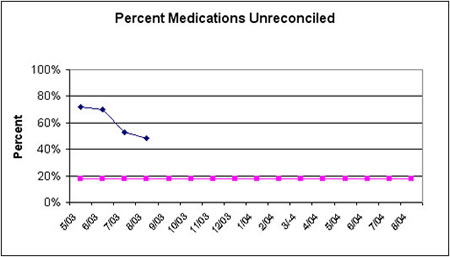 |
Home | Initiatives | Patient Safety Store | Education | Consumers |
| Board of Directors | Contact Us | Links | Donations | ||
Initiatives
Core Evaluation Measure
Percent Medications Unreconciled (on reviewed charts)
| Total # of unreconciled medications on reviewed charts | X 100 |
| Total # of patient medications on those charts |

To ensure consistency across all projects, the Collaborative Leaders are encouraging all participants to use the measure “Percent Medications Unreconciled” as the primary measure to evaluate their performance. Excel spreadsheets for recording data and generating charts of your results, along with instructions for data collection and an FAQ listing of responses to participant questions about the data collection process are all available on the Coalition WEB site (www.macoalition.org)
NOTE: The Collaborative originally worked with a measure defined as “Reconciling Errors (unreconciled medications) per 100 Admissions” for the core measure, but hospitals generally preferred having a measure with the units expressed as a percentage. The numerator in both measures is identical, but the current measure divides the number of unreconciled medications by the total number of medications reviewed, rather than by the number of patient charts reviewed. Also, some hospitals are expressing the core measure in a positive fashion – Percent Medications Reconciled – with performance improvements showing an increase in the measure rather than the decline shown above.
Summary of Evaluation Measures for Reconciling Collaborative
Core evaluation measure: Percent Medications Unreconciled
Examples of error prevented: Concrete evidence of both medication errors at your institution that could have been prevented by the reconciling process and, after your implementation, potential errors that were prevented by the process can become strong testimony to your project’s success. The chart abstraction process for collecting the data for the Percent Medications Unreconciled measure can also be used to collect evidence such as the following:
- # home medications omitted
- # of medication orders changed
- specific examples of errors prevented
Measures of overall penetration of reconciling process: A good measure of your ability to penetrate your reconciling initiative throughout your organization can be calculated by simply measuring:
- Percent of patients with completed reconciling form in their chart
Measures linked to each test of change: A sampling of measures that have been used to evaluate small tests of change for individual implementation phases is provided on the following page. These would include process measures (% patients arriving at hospital with medication lists, % staff trained in reconciling process) and information collected from informal staff and patient surveys.
Adverse drug events: The long-term goal of the Reconciling Medications Collaborative is to reduce adverse drug events. However, because of the complexity of collecting data on ADEs and their relatively infrequent occurence, the need to develop data for an ADE measure can become a barrier to implementation teams. As a result, the Collaborative has chosen to emphasize the Percent Medications Unreconciled measure, while recognizing the value of measures of medication errors that lead to patient harm. Documentation on ADE measurement strategies, including use of the IHI “trigger tool”, one methodology for developing data on Adverse Drug Events 10,000 Doses, is available on request.
Examples of Evaluation Measures
An evaluation measure needs to be linked to each test of change.
Refer to the “Getting Started” implementation materials for
examples of small tests of change that would be linked to measures such
as those found on this list.
% medications unreconciled (Core Measure for Collaborative Use)Measures of errors intercepted and medication errors
Unreconciled medications per 100 admissions
# unreconciled meds
#, % medications unreconciled within specified timeframe (e.g. before next therapeutically prescribed dose; within 4 hours for high-risk set of drugs, etc.)
#, % of medication orders changedProcess measures
#, % of patients with at least one medication order changed
# potential medication errors intercepted
# home meds not ordered on admission
# of additions with interactions
# of omits, # of wrong dose, # of wrong schedule, # of wrong time
# adverse drug events
PRN score from FMEA of target medication process steps
Adverse drug events per 10,000 doses
Reconciling form created/piloted
RN satisfaction/ease of use of reconciling form evaluated
% patients with completed reconciling form in their chart
% patients in target sample with completed reconciling form
% patients in target sample with reconciling form in correct location in the chart
# pharmacy consults
accessibility of pharmacy information on floor
% patients arriving at hospital with medication lists
% patients arriving at hospital with accurate medication list (complete, current)
% staff trained in reconciling process (% RNs, % clinical staff, % pharmacists)
Post-test results measuring efficacy of education efforts
# of charts audited each month
# leadership sessions with examples of errors/potential errors discussed, core evaluation data charts reviewed
| Home | | | Initiatives | | | Patient Safety Store | | | Education | | | Board of Directors | | | Contact Us | | | Links | ||
| Email questions or comments about this website to | ||||||||||||||
|
|
||||||||||||||